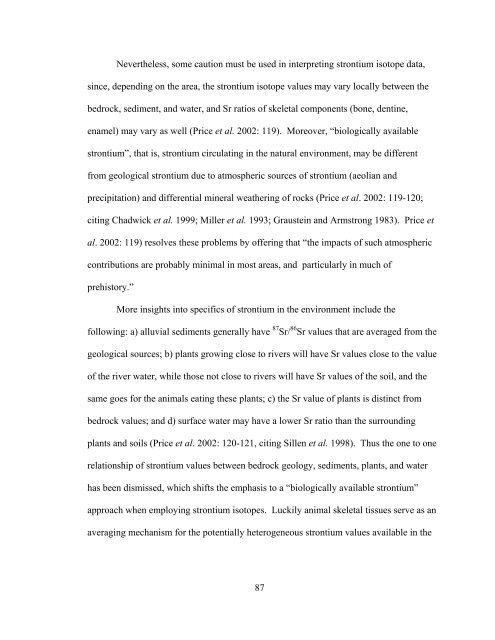Tracing the Source of the Elephant And Hippopotamus Ivory from ...
Tracing the Source of the Elephant And Hippopotamus Ivory from ...
Tracing the Source of the Elephant And Hippopotamus Ivory from ...
You also want an ePaper? Increase the reach of your titles
YUMPU automatically turns print PDFs into web optimized ePapers that Google loves.
Never<strong>the</strong>less, some caution must be used in interpreting strontium isotope data,<br />
since, depending on <strong>the</strong> area, <strong>the</strong> strontium isotope values may vary locally between <strong>the</strong><br />
bedrock, sediment, and water, and Sr ratios <strong>of</strong> skeletal components (bone, dentine,<br />
enamel) may vary as well (Price et al. 2002: 119). Moreover, “biologically available<br />
strontium”, that is, strontium circulating in <strong>the</strong> natural environment, may be different<br />
<strong>from</strong> geological strontium due to atmospheric sources <strong>of</strong> strontium (aeolian and<br />
precipitation) and differential mineral wea<strong>the</strong>ring <strong>of</strong> rocks (Price et al. 2002: 119-120;<br />
citing Chadwick et al. 1999; Miller et al. 1993; Graustein and Armstrong 1983). Price et<br />
al. 2002: 119) resolves <strong>the</strong>se problems by <strong>of</strong>fering that “<strong>the</strong> impacts <strong>of</strong> such atmospheric<br />
contributions are probably minimal in most areas, and particularly in much <strong>of</strong><br />
prehistory.”<br />
More insights into specifics <strong>of</strong> strontium in <strong>the</strong> environment include <strong>the</strong><br />
following: a) alluvial sediments generally have 87 Sr/ 86 Sr values that are averaged <strong>from</strong> <strong>the</strong><br />
geological sources; b) plants growing close to rivers will have Sr values close to <strong>the</strong> value<br />
<strong>of</strong> <strong>the</strong> river water, while those not close to rivers will have Sr values <strong>of</strong> <strong>the</strong> soil, and <strong>the</strong><br />
same goes for <strong>the</strong> animals eating <strong>the</strong>se plants; c) <strong>the</strong> Sr value <strong>of</strong> plants is distinct <strong>from</strong><br />
bedrock values; and d) surface water may have a lower Sr ratio than <strong>the</strong> surrounding<br />
plants and soils (Price et al. 2002: 120-121, citing Sillen et al. 1998). Thus <strong>the</strong> one to one<br />
relationship <strong>of</strong> strontium values between bedrock geology, sediments, plants, and water<br />
has been dismissed, which shifts <strong>the</strong> emphasis to a “biologically available strontium”<br />
approach when employing strontium isotopes. Luckily animal skeletal tissues serve as an<br />
averaging mechanism for <strong>the</strong> potentially heterogeneous strontium values available in <strong>the</strong><br />
87

















